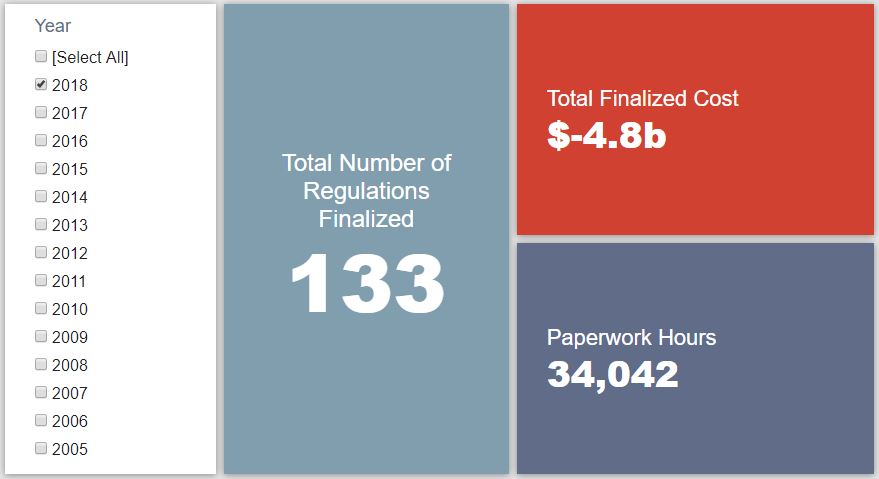Week in Regulation
June 25, 2018
A Regulatory Week – With A Caveat
Driven largely by one proposed rule, last week saw a net increase in regulatory costs—but the devil is in the details. A single shift in the analytic framework could actually make it a net deregulatory week. Between both proposed and final rules, agencies published roughly $566.1 million in net costs and 54,648 hours of new paperwork. The per capita regulatory burden for 2018 is negative $14.53.
Regulatory Toplines
- New Proposed Rules: 47
- New Final Rules: 77
- 2018 Total Pages of Regulation: 29,204
- 2018 Final Rules: -$4.8 Billion
- 2018 Proposed Rules: $9 Billion
The most notable regulatory action of the week came in National Oceanic and Atmospheric Administration (NOAA) measure regarding “Taking and Importing Marine Mammals; Taking Marine Mammals Incidental to Geophysical Surveys Related to Oil and Gas Activities in the Gulf of Mexico.” NOAA estimates that this proposed rule could impose nearly $800 million in total cost (or $182 million annually). As such, NOAA considers it a “regulatory” action.
This analysis, however, hinges upon a particular baseline assumption. That baseline hinges upon whether NOAA should judge it under circumstances prior to a 2013 “settlement agreement” on the matter (the current, primary assumption) or one that considers a post-2013 framework (the alternative). The reason for this split is that the agreement in question is set to expire later this year. If NOAA finds that post-2013 framework is the more valid approach, such a scenario would mean the eventual rule would produce $646 million in net savings ($147 million annualized). Interested parties have until August 21 to contribute comments.
Tracking Regulatory Modernization
There was one “regulatory” action this past week that added costs to the regulatory budget established by Executive Order (EO) 13,771. This rule makes further adjustments to the compliance timeline for a 2017 update of “Federal Policy for the Protection of Human Subjects” across all agencies (although the Department of Health and Human Services (HHS) is the primary agency involved). While the rulemaking establishes certain deregulatory measures, HHS finds that – on net – affected entities will face roughly $2 million in new annual costs. Nevertheless, HHS is still very much on track for an overall deregulatory Fiscal Year (FY) 2018. Out of its rules that include quantified estimates, it currently has seven deregulatory actions versus three regulatory actions and currently exceeds its FY 2018 savings goal by more than $285 million.
According to AAF analysis, since the start of FY 2018 (beginning Oct. 1, 2017), executive agencies have promulgated 40 deregulatory actions with quantified estimates against six regulatory measures that impose costs, under the rubric created by EO 13,771 and the administration’s subsequent guidance document on the matter. These rules combine for net annual savings of roughly $1.2 billion. This means that agencies have thus far surpassed the administration’s cumulative goal for FY 2018 of $687 million in net annual savings. In fact, according to the administration’s latest Unified Agenda, agencies are on track to roughly double that goal.
Click here to view AAF’s examination of the administration’s progress under the “one-in, two-out” executive order through the end of Fiscal Year 2017.
State of Major Obama-Era Initiatives
Based on total lifetime costs of the regulations, the Affordable Care Act has imposed costs of $52.9 billion in final state and private-sector burdens and 176.9 million annual paperwork hours.
Since passage, the Dodd-Frank financial reform legislation has produced more than 82.9 million final paperwork burden hours and imposed $38.9 billion in direct compliance costs.
Total Burdens
Since January 1, the federal government has published $4.2 billion in net costs (despite $4.8 billion in net savings from final rules) and new paperwork burdens amounting to 2.6 million hours (including 34,042 new hours from final rules). Click here for the latest Reg Rodeo findings.











